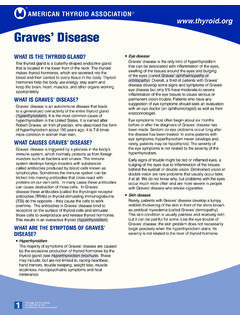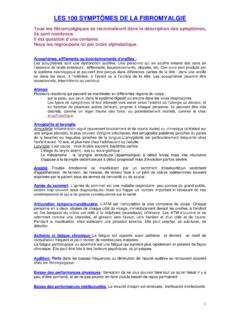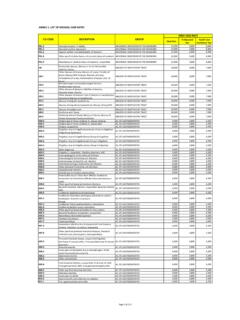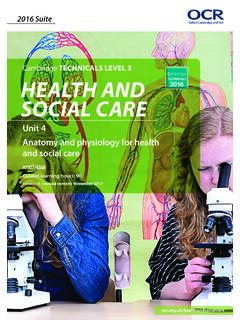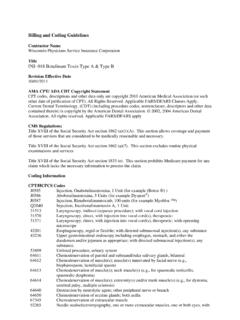Transcription of THE AMERICAN THYROID ASSOCIATION (ATA)
1 Hypothyroidism AMERICAN THYROID ASSOCIATION (ATA)Copyright 2019 AMERICAN THYROID ASSOCIATION (ATA)2 PAGETHE AMERICAN THYROID ASSOCIATION (ATA)The AMERICAN THYROID ASSOCIATION (ATA) is the leading organization devoted to THYROID biology and to the prevention and treatment of THYROID disease through excellence in research, clinical care, education, and public health. ACKNOWLEDGEMENTSThe ATA gratefully acknowledges the current and past members of the ATA Clinical Affairs Committee and the ATA Patient Education & Advocacy Committee as contributors and authors to this booklet; all educational information for patients and the public posted on the ATA website ; as well as articles and updates disseminated through Friends of the ATA and the Clinical Thyroidology for Patients.
2 ATA PATIENT RESOURCESThe ATA patient resources are designed to provide up-to-date information for THYROID patients, their families and other interested public communities. The ATA is dedicated to serving as an educational resource for the public by supporting THYROID research and promoting the prevention, treatment and cure of THYROID -related diseases and THYROID cancer. The information contained in or made available through the ATA Website is not intended to replace the services of a trained health professional or to be a substitute for medical advice of physicians. The user should consult a physician in all matters relating to his or her health, and particularly in respect to any symptoms that may require diagnosis or medical attention.
3 The AMERICAN THYROID ASSOCIATION makes no representations or warranties with respect to any information offered or provided within or through the ATA Website regarding treatment, action, or application of medication. Neither the ATA nor any of its Affiliates will be liable for any direct, indirect, consequential, special, exemplary, or other damages arising therefrom. AMERICAN THYROID ASSOCIATION6066 Leesburg Pike, Suite 550 Falls Church, VA 22041 AMERICAN THYROID ASSOCIATION (ATA)Copyright 2019 AMERICAN THYROID ASSOCIATION (ATA)3 PAGETABLE OF CONTENTSThe AMERICAN THYROID ASSOCIATION (ATA) .. 2 Acknowledgements .. 2 ATA Patient Resources .. 2 AMERICAN THYROID ASSOCIATION .
4 2 Hypothyroidism .. 4 What is the THYROID ? .. 4 What is hypothyroidism? .. 4 Who can develop hypothyroidism? .. 4 Factors contributing to risk of developing hypothyroidism: .. 5 Symptoms .. 5 Common FEATURES of hypothyroidism .. 5 Causes .. 6 Prevention .. 7 Diagnosis ..7 Changes in how you feel ..7 Medical and family history ..7 Physical exam .. 8 THYROID Blood Tests ..8 TSH and T4 Blood tests .. 8 Biotin Interference ..8 Ways that hypothyroidism cannot be diagnosed .. 9 Treatment ..9 Thyroxine (T4) replacement .. 9 Who should treat you ..9 Thyroxine Dose Factors ..9If you become pregnant .. 11 Treatment 12 Follow-up .. 13 Repeat blood tests.
5 13 Normal variation in TSH levels .. 13Be sure to follow up with your doctor if .. 14If hypothyroidism is not treated or if treatment is stopped ..14 Babies and children .. 14 Hypothyroidism caused by iodine deficiency .. 14 People of all ages .. 14 Severe hypothyroidism (myxedema) ..14 Keeping other people informed .. 15 Tell your family .. 15 Tell your other doctors and pharmacist ..15 Partnership between you and your doctor .. 15 Your emotional needs .. 15 Living with hypothyroidism .. 16 Many questions about hypothyroidism remain mysteries ..16 Medical Terms in this Booklet ..16To learn more ..19 Hypothyroidism AMERICAN THYROID ASSOCIATION (ATA)Copyright 2019 AMERICAN THYROID ASSOCIATION (ATA)4 PAGEHYPOTHYROIDISMWHAT IS THE THYROID ?
6 The THYROID is a butterfly-shaped endocrine gland located in the lower front of the neck below the larynx (the voice box). The THYROID s job is to make THYROID hormones, which are secreted into the blood and then carried to every tissue in the body. THYROID hormone helps the body use energy, stay warm and keep the brain, heart, muscles, and other organs working as they should. The main hormone made by the THYROID is thyroxine, also called T4 because it contains four iodine atoms. Small amounts of another and more potent THYROID hormone containing three iodine atoms, triiodothyronine (T3), are also made by the THYROID gland. However, most of the T3 in the blood is made from T4, via the removal of an iodine atom, in other body tissues.
7 THYROID hormones control the way every tissue in your body uses energy. They are essential to help each cell in your body s tissue and organs work right. For example, THYROID hormone controls the body s temperature, heart rate, blood pressure, and the rate at which food is turned into energy (metabolism). WHAT IS HYPOTHYROIDISM?Hypothyroidism is a kind of THYROID disease. If you have hypothyroidism that means you have an underactive THYROID ( hypo- means under or below normal ). In people with hypothyroidism, the THYROID does not make enough THYROID hormone to keep the body running normally. Common causes of hypothyroidism are autoimmune disease, surgical removal of the THYROID , and radiation treatment.
8 Low THYROID hormone levels cause the body s functions to slow down, leading to general symptoms like dry skin, fatigue, loss of energy, and memory problems. Hypothyroidism is diagnosed by a simple blood test for THYROID -stimulating hormone (TSH). Hypothyroidism is treated by replacing the missing THYROID hormone with synthetic thyroxine pills, which usually haveto be taken every day for life. With daily treatment, most patients recover completely. WHO CAN DEVELOP HYPOTHYROIDISM?Hypothyroidism is one of the most common THYROID diseases. It affects people all over the world of every age, sex, race, and level of wealth and education. About 2 percent of Americans have hypothyroidism and as many as 10% have mild hypothyroidism.
9 More than half of those with hypothyroidism do not know they have it. WHAT CONTRIBUTES TO THE RISK OF DEVELOPING HYPOTHYROIDISM? Hypothyroidism is more common in women than men; and, much more so in young women than young men. The risk of hypothyroidism increases during pregnancy, after delivery and around menopause. Hypothyroidism is more common in whites and Asians than in other races and ethnicities. Hypothyroidism can develop at any age, but the risk for developing it increases with age. The risk of hypothyroidism is increased in many situations, including: n Having another autoimmune disorder, such as type 1 diabetes, rheumatoid arthritis, multiple sclerosis, celiac disease, Addison s disease, pernicious anemia, or Having a close relative, such as a parent or grandparent, with an autoimmune Having had previous THYROID surgery, radioactive iodine treatment, or radiation therapy to the neck or upper Having Down syndrome or Turner syndrome (which are genetic disorders) n Having bi-polar disease (manic depression) n Taking certain medications, such as lithium, amiodarone, pembrolizumab, nivolumab Hypothyroidism AMERICAN THYROID ASSOCIATION (ATA)Copyright 2019 AMERICAN THYROID ASSOCIATION (ATA)
10 5 PAGESYMPTOMSH ypothyroidism has a variety of symptoms. Symptoms are something you see, feel and/or experience yourself. Many of these symptoms are often confused with other health conditions. When your THYROID hormone levels are too low, your body s cells cannot get enough THYROID hormone. This causes your body s processes to start slowing down. For example, the body makes less heat and less energy, causing organs like the brain and bowels to move more slowly. As the body slows, you may notice that you feel colder, you tire more easily, your skin is getting drier, you are becoming forgetful and depressed, and you are getting constipated. Symptoms of hypothyroidism usually appear slowly over several months or years.
